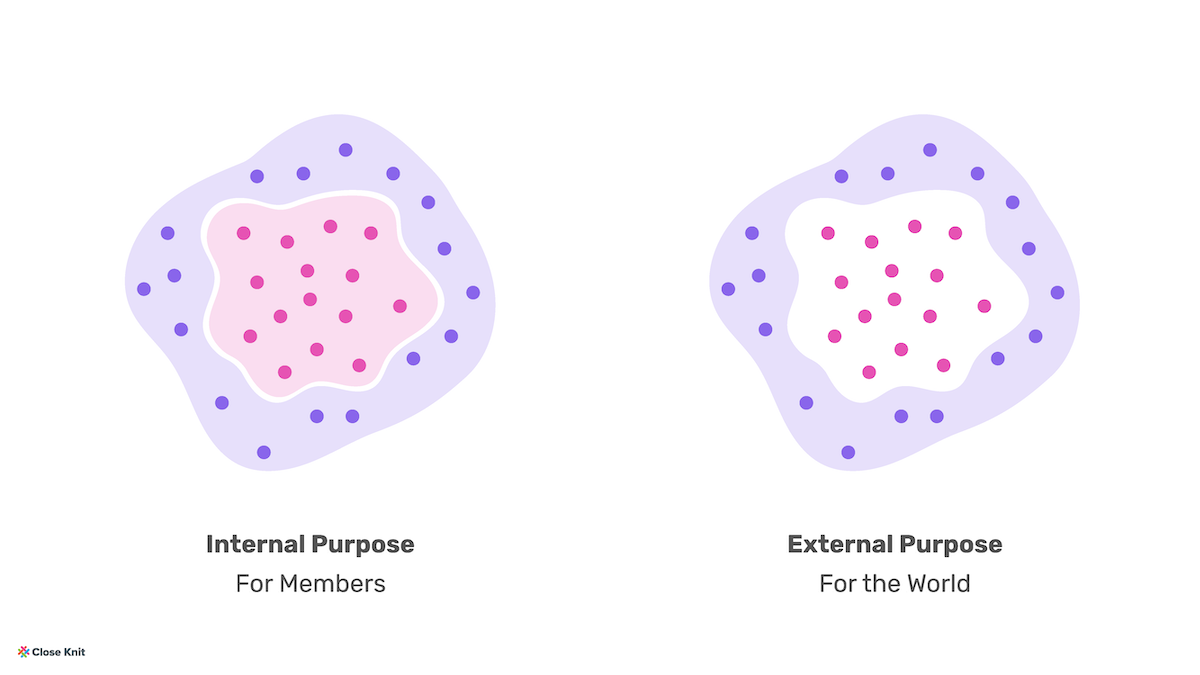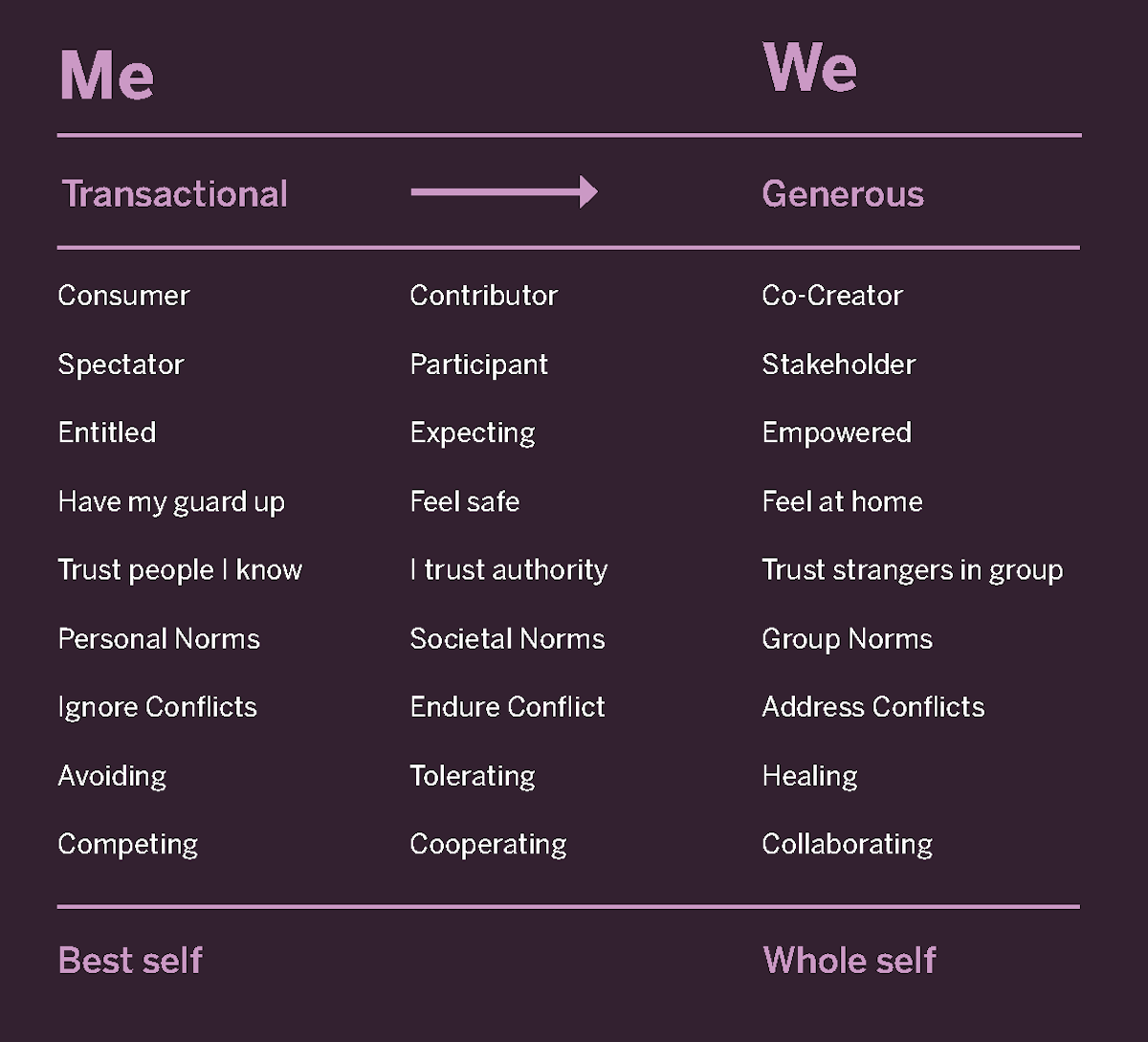Belonging
At the core of every community is a sense of belonging. It defines a community’s who and why, its purpose, and the value it provides to its members and the world.

Images Courtesy of Close Knit
By Sascha Mombartz
First and foremost, to belong is to be related to and a part of something. It is membership, the experience of being at home in the broadest sense of the phrase. It is the opposite of thinking that wherever I am, I would be better off somewhere else. Or that I am still forever wandering, looking for that place where I belong. The opposite of belonging is to feel isolated and always (all ways) on the margin, an outsider. To belong is to know, even in the middle of the night, that I am among friends.
Peter Block, Author and Consultant on Community & Civic Engagement
We will explore the following three categories, according to Peter Block (1), that comprise how someone feels like they belong:
- Belonging to Community
- Community Belonging to You
- Longing for Community
Belonging to Community
You belong to a community when you have something in common with the people around you. This commonality can be either by circumstance or by choice. It has to be more than a superficial token and more of a deep, meaningful trait, experience, or belief that can’t easily be replaced. It needs to be believable and evoke a sense of trust. What and how much you need to have in common to pass this thresh-old depends on the nature of the commonality and the people involved. There’s also the question of mutuality: Do you, as much as everyone around you, feel that you belong together? In its strongest form, belonging to a community also means that the community itself claims you as their own and that they will be there for you, listen to you, and support you.
Circumstance
Circumstance can mean you’re connected through:
- Place, where you grew up or where you studied.
- Shared history, which can be an external event.
- Powerful experiences such as success, failure, or trauma.
- Your heritage, in the form of a set of shared values or cultural norms.
- Peers and elders that are made up of your co-workers, friends, and family.
- Inherent traits such as your age or identifying gender.
Choice
Communities of Choice can be established through:
- Practice and affinity, that is your profession, your hobbies, or interests to learn something from each other or create a change in yourself. Fan communities and sports clubs are some more examples.
- Action, which means you’re creating change in your community or in the world. These are often movements—environmental or political for example—that are time- or goal-based.
- Intentional communities where you would select the place and people
you want to be around. Co-living or cooperatives are examples.

Community Belonging to You
As much as you belong to a community, it also has to belong to you. This crucial piece is often overlooked or not well understood, and it’s also one of the harder pieces of the community puzzle. How can a community start belonging to its members? Members have to put them-selves and their energy into the community by contributing and co-creating. This stake and say in the community allows them to become a part of it. This is a virtuous cycle, the more you care, the more you contribute; the more you contribute, the more you belong; and the more you belong, the more you care to shape the community.
We need knowledge of how to care. That knowledge, it’s called emotional intelligence now. We need knowledge of how to share. It’s a capacity we’ll need more and more in the future. In a period of privatization, in a period of extraction.
Vandana Shiva (2)
Co-Creation
Co-creation means that members have to be invited to contribute and are given the tools, trust, and autonomy to do so. The best environment for this is one in which everyone feels like a teacher and a student at the same time, with a willingness to share but also an openness to learn. The challenge is finding the right balance between structure, hierarchy, and authority, and creating an organization that can both be centralized and distributed as needed.
You know you have the right balance when contributors are honored for their effort and work, while also providing clear guidelines on expectations of commitments, use, and ownership. In the end, it’s about finding a balance between give and get, creating and receiving, group dynamic, individual efforts, and leadership. Gillian Davis, a leadership coach, uses this analogy of a Leadership Pendulum (3):
The key is knowing when to let the group dynamic flow and allow for self managed work and when it’s time to step in, bring the constraints and the direction back.
Gillian Davis
Longing for Community
The third pillar is the hardest to see, because it lives deep inside of us. It’s part of our biology and evolution as social animals. We’ve all felt it. It’s a feeling of calm that arises when everything feels clear and falls into place. It can manifest itself as love for a person, a place, or an idea, and makes you feel like you belong together. It can give you purpose and make you whole.
People form social attachments readily under most conditions and resist the dissolution of existing bonds. Belongingness appears to have multiple and strong effects on emotional patterns and on cognitive processes. Lack of attachments is linked to a variety of ill effects on health, adjustment, and well-being. Roy Baumeister, (4) Social Psychologist, and Mark Leary, (5 ) Professor of Psychology in The Need to Belong: Desire for Interpersonal Attachments as a Fundamental Human Motivation



Inspired by an article from Fabian Pfortmüller & Michelle Bachman (6)
It’s in our Nature
This belonging is deeply biological. In his book Culture Code, (7) Daniel Coyle talks about belonging cues. These cues are processed in our amygdala, the part of our brain that subconsciously manages our fight or flight response. In other words, it helps us interpret a situation and decide if it’s safe or dangerous. These belonging cues build and sustain our social bonds. Community is deeply ingrained in our biological survival instincts. For our ancestors, being around the right people who cared for each other could mean the difference between life and death. Humans have traditionally been very aware of their interconnectedness to each other, their environment, and the effects of their behavior on nature’s intricate ecosystem—an ecosystem that to flourish requires harmonious and symbiotic relationships. As an extension of that, belonging is also very much about caring. Caring is defined as feeling concern or interest for, attach-ing importance to, feeling affection toward, or providing for the needs of something or someone. This can be understood in a transactional way: as in caring for ourselves or our own interests, in a more generous sense: as in providing for others, or in the most selfless way: seeing ourselves as part of a larger eco-system that we must contribute to because we are part of it. Health & Happiness There have also been a number of studies on the effects of our social bonds on our health and happiness. In a fascinating Harvard study (8) that is one of the world’s longest studies of adult life (ongoing since 1938), director Robert Waldinger revealed: “Our relationships and how happy we are in our relationships has a powerful influence on our health.” Susan Pinker, another psychologist, found that the biggest factors for a long life are our social integration and close relationships.9 These factors were a bigger indicator for longevity than exercising or quitting smoking or drinking. Again, being around people you can trust, feel safe with, and rely on is a fundamental need that we have.
Conclusion
Belonging is threefold: You belong to community, it belongs to you, and you have a longing for it. We belong to community either by circumstance (through shared history, experience, traits) or by choice (through affinities, practices, actions). Community belongs to us when we contribute and co-create, and change our perspective from me to we. Our longing for community comes naturally, it’s a deeply biological need for connection, which allows us to live happier and healthier lives. A sense of belonging starts to answer the questions of who and why we are here together. This understanding can not only help you clarify and communicate your membership criteria, but also your internal and external purpose, vision, mission, and values that will guide your community.
To learn more about Close Knit and the initiative’s offerings, please visit
www.closeknit.co
(1) https://www.amazon.com/Community-Structure-Belonging-Peter-Block/dp/1605092770/?tag=community20-20
(2) https://www.facebook.com/playgroundenglish/videos/609794979353836/
(3) https://www.closeknit.co/blog/community-leadership-energy-space-the-pendulum
(4) https://psy.fsu.edu/faculty/baumeisterr/baumeister.dp.php
(5) https://sites.duke.edu/leary/
(6) https://medium.com/together-institute/there-are-two-ways-to-show-up-in-a-community-as-a-consumer-or-as-a-co-creator-6c12939a8c8d
(7) https://www.amazon.com/Culture-Code-Secrets-Highly-Successful/dp/B077B1WF85/?tag=community20-20
(8) https://news.harvard.edu/gazette/story/2017/04/over-nearly-80-years-harvard-study-has-been-showing-how-to-live-a-healthy-and-happy-life/
(9) https://www.npr.org/transcripts/842604367
